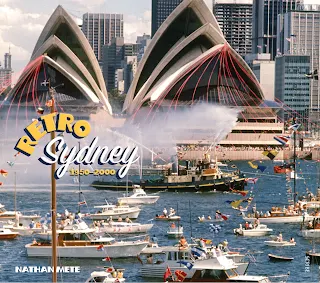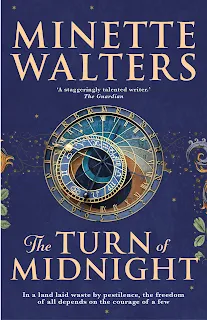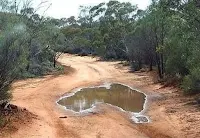* Copy courtesy of Text Publishing *In
Corners of Melbourne - The Great Orange-Peel Panic and Other Stories from the Streets, Australian author Robyn Annear takes us through some of the interesting early history of the intersecting streets and corners of Melbourne.
Right out of the gate, the subtitle of this book introduced me to the nuisance and hazard of orange peel on the newly laid flagstone paving on Melbourne's footpaths. As a street food, oranges were healthy, cheap and nourishing, but when:
"...leather-soled shoes met orange peel dropped on flagstones, a diabolical hazard to pedestrians ensued." Page 5
But how much orange peel are we talking about here? A correspondent writing to the Argus stated that one afternoon he removed 17 pieces of orange peel from the west side of Elizabeth street over the course of one hour. Okay, that sounds like a lot!
"At issue was how the 'peripatetic orange-eater' (a distinct urban type) disposed of the empty wrapper, which was often by scattering peel on the footpath as they went along. There were no bins back then, but there was a 'proper receptacle' for street waste - namely, the gutter. Bluestone channels, wide and deep enough to require footbridges for crossing, ran along either side of Melbourne's main streets." Page 6
Broken limbs, concussions and even deaths resulted from these nasty falls but orange peel wasn't the only danger.
"All it took was a stray spark from a discarded match or cigar butt on the footpath for a woman to be engulfed in flames. Skirts lanterned out by crinoline cages or billowing cotton petticoats were so frightfully flammable that accounts of women killed or maimed by dress fires were almost daily news." Page 17
This brings to mind my review of
Fashion Victims - The Dangers of Dress Past and Present by Alison Matthews David, so be sure to check that out if you have an interest in how your clothes could kill you in the past. Remember those bluestone channels? When it rained in Melbourne, flash flooding could cause those deep gutters to flow with a very fast rushing current, often flooding the corner of Elizabeth Street and Flinders Street. Pedestrians couldn't see the footbridges, were swept off or fell into the waters and some even found themselves trapped and drowned beneath the footbridges. Hard to imagine isn't it, drowning in the street?
If you managed to dodge the orange peel, avoid being set alight or drowning on the early streets of Melbourne, you might be hard pressed to avoid being startled or trampled by a horse.
"When trains first ran from Flinders Street, the train whistle had 'a very terrifying effect' on horses - young ones in particular. With the advent of trams, it was the clang of the gripman's bell. The scrape of a street sweeper's shovel, an umbrella being shaken, a dog's bark, a thunderclap: any sudden noise or movement might set a horse off." Page 48
Annear follows with many accounts of horses being spooked, with or without their rider as well as with or without their cart, buggy or coach. Good samaritans trying to slow or stop a runaway horse/s were often hurt or killed in the process and pedestrians, passengers and cart drivers themselves were frequently knocked down, bowled over, trampled or crushed.
The installation of an elaborately designed fountain at the intersection of Swanston and Collins Streets seems impossible to imagine now. Installed in 1859 and named the Victoria Fountain, it was designed to provide water to the public and included a horse trough, making it a convenient place to stop. The water and subsequent animal droppings made the area muddy and the watering of horses and livestock regularly disrupted the flow of traffic in both directions. Reading the resistance from the public and efforts from the council reminded me that some things don't change and the fountain was swiftly relocated to Carlton Gardens, a 'poorly cultivated pleasure-ground' at the time.
Understandably, sanitation was a problem, and the city's laneways became public urinals. Annear tells us we can still see remnants of this time:
"There are a couple of laneways in central Melbourne where an injunction to Commit No Nuisance can still be seen, painted on the wall at eye level. Translated from Victorian bureaucratese, it means: Do Not Piss Here." Page 77
I thought those signs meant no graffiti, or keep the noise down. The first public urinals in the city were immediately popular and rapidly exceeded all expectations. (No facilities for women mind you!) These urinals provided privacy but directed the urine down into the gutters, hence saving the alleyways, but still stinking out the public. One such urinal close to the Theatre Royal was allegedly visited by 1,897 men over a six hour period on a Saturday night. Imagine the volume of urine produced! Unfortunately this was nothing compared to the estimated 10,000 patrons utilising the urinals located on Bourke Street every week.
"The gutters were sluiced regularly - if not often enough - by sanitation workers authorised to uncork the fireplugs that stood at intervals on the edge of city streets." Page 87
According to an article in the
Herald from January 1822:
"Truly Melbourne might be fairly called the city of stinks. Last night the stench arising from the gutters in Elizabeth Street was particularly noseable...Even those well accustomed to the malodorous atmosphere of this particular thoroughfare stood aghast, and ultimately fled." Page 87
Changing topics, and another aspect from the
Corners of Melbourne was that of what to do with foundlings left on doorsteps and street corners. Unwanted children born to poor families, unwedded mothers, mistresses or victims of abuse were a significant problem:
"If a foundling's identity and parents couldn't be traced, the infant would be 'charged' with being a neglected child and presented at the local court. There, a bench of three magistrates would decide not only the child's fate, but its name." Page 119
The author goes on to tell us about the naming of Cecil Nicholson, Alexander South, August Studley, Henry Street, Ellen Park, Frances Wellington and more. I don't know why, but reading these names and hearing their stories makes me sad. Not knowing a child's identity somehow seems such a cruel and a lonely beginning for these and many more babies abandoned in this way.
On learning neglected children were committed to industrial schools by the court for up to 16 years, thankfully the author declares:
"But that's enough shit and misery for one chapter. Suffice it to know that the industrial schools - overcrowded, disease-ridden; short on privies and shorter on love - were no place for a child." Page 121
What a breath of fresh air! Annear seems to know when the reader has had enough of a topic, while her anecdotes and case histories gave me the feeling she was spinning yarns at a bar, or a campfire.
Stories of larrikins and gangs of boys spitting, throwing stones, stealing, harassing people and causing mischief somehow didn't engage my imagination as fiercely. Nor did the information around bill posting and advertising, and the rise and curse of hoardings in Melbourne. Having said that, I've been paying closer attention to hoardings and advertising since reading the book, and am able to 'see' with fresh eyes, noticing for the first time that the section of road underneath Richmond Station crossing over Punt Road now has organised and numbered billboards. When did that happen?
I was more interested in the history of pedestrian foot traffic and the changing of rules from 'keep to the right' and 'keep to the left'. A great one on escalators, did you know that prior to 1925, the city council had a regulation for pedestrians to 'keep to the right'. This rule meant that pedestrians had their backs to the road traffic - that was keeping to the left - essentially blinding them to hazards approaching them from behind.
"In Melbourne the change took effect in 1925. But there was resistance, with traditionalists calling the new rule 'absurd', 'farcical' and 'pettifogging'. Too bad: it was law. Now Keep to the Left was stencilled on the surface of city footpaths, with a continuous white line painted down the middle so there could be no mistaking where the left side became right (or wrong)." Page 237
Pettifogging means placing undue emphasis on petty or trivial details (thanks Google) and I found myself marvelling that white lines were ever drawn on the footpath to indicate a mandatory direction for pedestrians. That is, until I remembered the white lines and circles that appeared on pavements and floors during the pandemic telling us all where to stand and queue. It's interesting how some things change and others stay the same.
Overall, the material contained within
Corners of Melbourne was thoughtfully collated and gave me a sense of what I might encounter walking the early streets of Melbourne as it was expanding and developing into the city I now call home.
Recommended for history buffs and those with a non fiction interest in urban planning, social history, architecture or economic development. You can check out the first 72 pages for free on the publisher's
website.
For more, you can also check out my review of
Adrift in Melbourne by Robyn Annear.









































